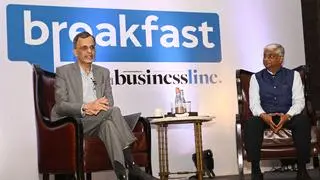The Indian economy slowed down further in the October-December quarter (Q3) as gross domestic products (GDP) grew at 4.4 per cent mainly on account of manufacturing de-growth and a slump in the services sector. The government, however, attributed this to the base effect and stressed that the growth momentum remained steady, with the expectation that 7 per cent growth would be achieved in the full fiscal of FY23.
GDP growth was 13.2 per cent and 6.3 per cent, respectively, in the April-June quarter (Q1) and the July-September quarter (Q2). This number was 5.2 per cent during Q3 of FY22. Post-revision to the figure, GDP grew by 9.1 per cent in FY22.
‘On the right track’
Meanwhile, the government remained unperturbed by the lower number. “Quarterly data is a bit noisy. They are also not seasonally adjusted,” Chief Economic Advisor V Anantha Nageswaran said, addressing the media virtually. “India is on the right track to achieve 7 per cent growth for the full fiscal of FY23. We just need a growth rate of 4 per cent in Q4 (January-March) to achieve a 7 per cent growth rate,” he said.
Data showed manufacturing de-growth of 3.6 per cent in Q2 and 1.21 per cent in Q3 of FY23. There is an opinion that rising interest rates have affected demand for goods and thus manufacturing. However, Nageswaran did not agree with this. He said on the one hand, rural demand is poised to grow in the coming year, and on the other, there is strong urban demand across all categories. “These can be reflected in the expectation about the sale of two-wheelers crossing pre-pandemic levels, the sale of tractors attaining new levels, and the sale of passenger vehicles (cars and MUVs) remaining at all-time highs with new launches. Air traffic is growing, so is housing sales,” he said.
Also read: Fiscal Deficit for April-January reached 68% of revised estimate
Growth of the services sector slowed from 16.3 per cent in Q1 to 9.4 per cent in Q2 and 6.2 per cent in Q3 of the current fiscal. Demand slowdown is reflected in the growth of Private Final Consumption Expenditure too as its share in GDP has come down to 61.6 per cent in Q3 of FY23 from 63 per cent in Q3 of FY 22.

Downside risks
Though CEA was confident about 7 per cent growth, he listed downside risks. He said global growth is forecast to slow from 3.4 per cent in 2022 to 2.9 per cent in 2023 as per the latest IMF’s World Economic Outlook, mainly on account of synchronised monetary tightening, adverse spillovers from prolonged strains in supply chains, and heightened uncertainty due to geopolitical conflict.
Also read: India’s core industries grow at 4-month high of 7.8% in January
According to Nageswaran, there is upside to India’s growth outlook. These include limited health and economic fallout for the rest of the world from the current surge in Covid-19 infections in China and, therefore, continued normalisation of supply chains. Improvement in animal spirits and providing further impetus to private sector investment and a stable macro-economy. “However, the scenario of subdued global growth presents two silver linings: oil prices will stay low and India’s CAD will be better than currently projected. The overall external situation will remain manageable,” he said.
DK Srivastava, Chief Economic Advisor with EY India, said that second advance estimates for 2022–23 have retained the overall annual growth rate at 7 per cent but revised the external sector contribution to this overall growth. In the first advance estimates, the contribution of net exports to real growth was (-)2.8 per cent points. This has improved by nearly 1 per cent point to (-) 1.9 per cent points. “This was counterbalanced by a fall in the domestic demand components, especially in private and government consumption expenditures. Thus, domestic demand appears to have weakened relative to the earlier estimate,” he said.











Comments
Comments have to be in English, and in full sentences. They cannot be abusive or personal. Please abide by our community guidelines for posting your comments.
We have migrated to a new commenting platform. If you are already a registered user of TheHindu Businessline and logged in, you may continue to engage with our articles. If you do not have an account please register and login to post comments. Users can access their older comments by logging into their accounts on Vuukle.